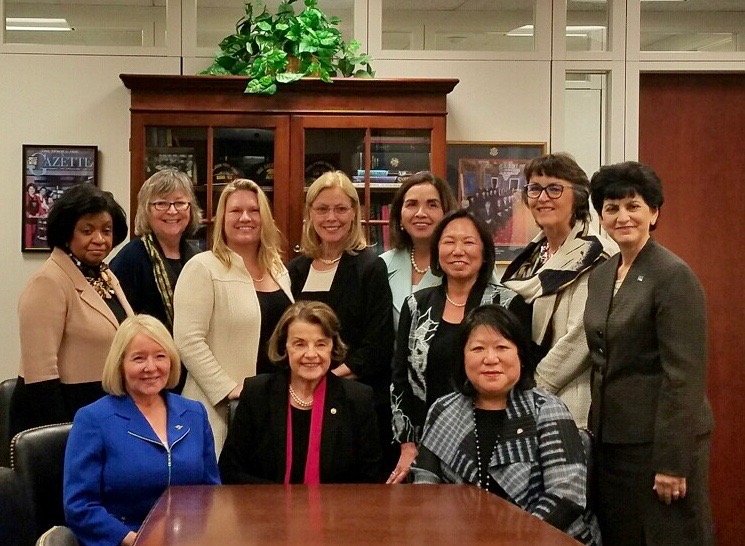From ‘The Hill’: Women’s History—and Future

President Hutchinson and 10 of the 12 CSU women presidents sit around Dianne Feinstein at a conference table.
Is there a better way to celebrate Women’s History Month than being surrounded by strong women leaders in higher education, policy, and politics? After this last week, I am convinced this is an ideal way to mark the occasion.
Each year, the California State University travels to Washington, DC, to meet with members of Congress and their staff about the importance of funding higher education and providing financial support to students earning college degrees. The Chancellor leads the CSU delegation composed of Board of Trustee members, students, campus presidents, government relations, and alumni staff.
This year, the trip to “The Hill” occurred in March. In honor of Women’s History Month, 10 of the CSU’s 12 women presidents joined Chancellor Timothy P. White in meetings with two legendary women leaders from California: Senator Dianne Feinstein and Speaker of the House Nancy Pelosi, both of whom have distinguished careers working to improve education, health care, and social services.

On the afternoon of March 26, my presidential colleagues and I began to gather outside of Senator Feinstein’s office in the Hart Building across the street from the Supreme Court. As more of us arrived, the excitement around meeting the distinguished senator was palpable. She was, understandably, running late because she was busy voting on the Senate floor at the Capitol. We didn’t mind—she was worth the wait. When Senator Feinstein appeared, we stood as if choreographed, snapped to attention, and greeted our host.
Chancellor White thanked her for meeting with us and presented her with a signed photograph of the CSU women presidents. I was filled with immense pride as he explained that the CSU has the highest number of women presidents than any other state university system in the country. For comparison, the American Council on Education reports the number of women university presidents at four-year institutions across the country remains at roughly 30%. In the California State University, 12 of 23 campuses are led by women presidents—or 52%.
As busy as Feinstein was that day, she greeted us warmly and facilitated a focused discussion about student access to affordable higher education, as well as the CSU’s work to create gender equity among its leadership. When she heard that I was from Chico State, she immediately changed the topic and asked how Paradise was doing and about the impact to Chico and the region. I appreciated the sincerity of her questions and answered them as clearly as I could.
To be sitting across the conference table from a woman with such incredible experience was humbling. When Feinstein graduated from Stanford University in 1955, white male professors and students dominated the classrooms and professional careers outside of the home. With a bachelor’s degree in art history, Feinstein began her career in city government in San Francisco. She was elected to the Board of Supervisors in 1969. In 1978, she was board president when City Supervisor Harvey Milk and Mayor George Moscone were assassinated. She assumed the office of mayor, succeeding Moscone and becoming the first woman to serve in that role. After an unsuccessful run for governor, Feinstein won a special election for US senator in 1992 and has served every year since.
Meeting Speaker of the House Nancy Pelosi was a very different yet equally enriching experience. We women presidents had the honor of meeting her during a private reception celebrating Women’s History Month at the National Statuary Hall located in a wing of the Capitol. When we were escorted to a beautiful rotunda, we were excited to learn Speaker Pelosi would be honoring the brilliant black women mathematicians of NASA—Dorothy Vaughan, Mary Jackson, Katherine Johnson and Christine Darden—who were essential to the American space program and our ability to place a man on the moon (as represented in the movie Hidden Figures). I listened in rapt attention as Johnson’s daughter reminisced about how astronaut John Glenn asked NASA to double check the calculations of the IBM computer with her mother to make sure that they were correct before he was willing to be launched into space.

When the reception was over, Speaker Pelosi made her way to our group where Chancellor White presented her with the picture of the CSU women presidents, and she took a picture with us. To be in the room with such brilliant and accomplished women was ultimate tremendous honor.
These two meetings were invigorating experiences in a whirlwind of meetings and discussions on higher education. Looking back, I can say we accomplished our goals on The Hill, as our group shared impassioned stories about higher education with our elected officials and lobbied for support of our institutions, which are truly educating the leaders of tomorrow.
But the memories I will carry with me forever are of meeting Feinstein and Pelosi, and learning more about the brilliant black women mathematicians of NASA. Surrounded by nine other female leaders of one of the premier systems of higher education in the world, it made me appreciate the progress we have made in women’s rights and gave me hope for the long road to equality that remains ahead.


